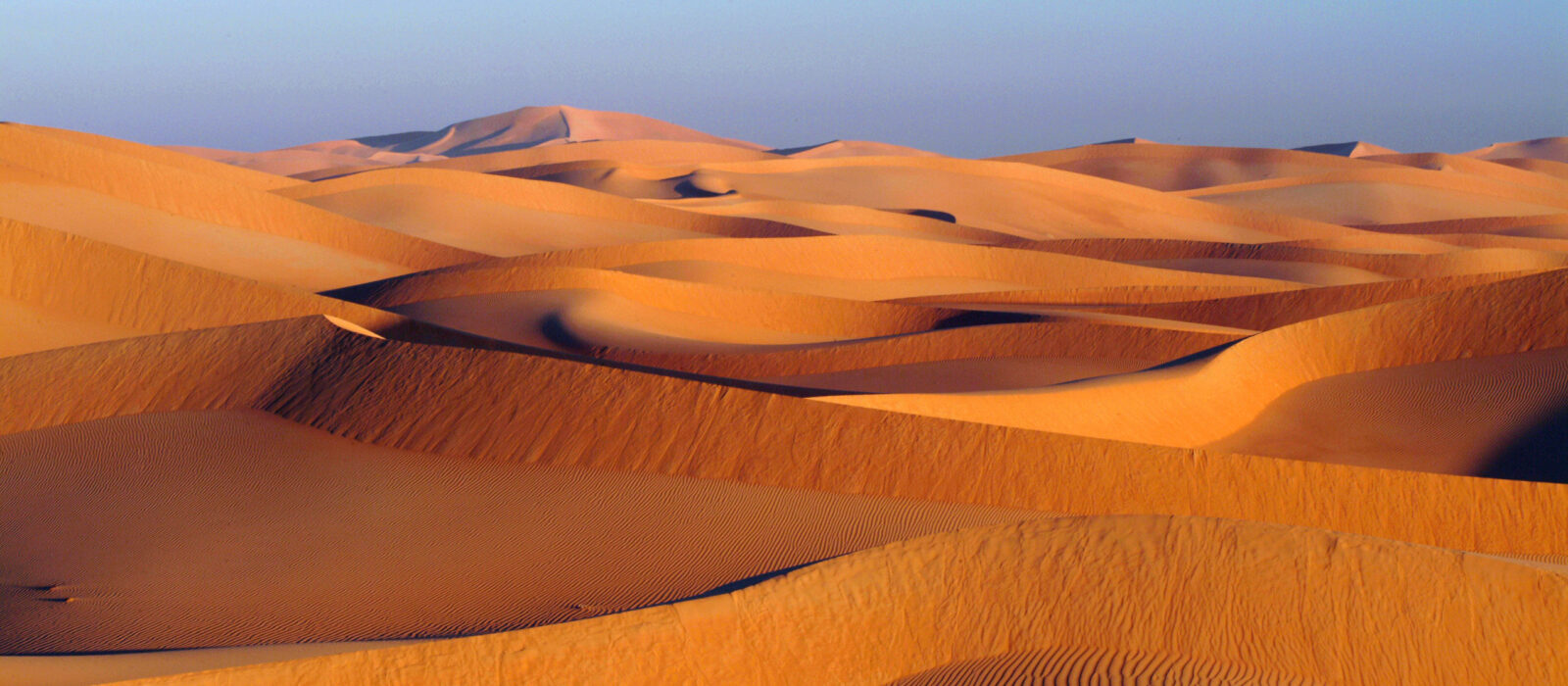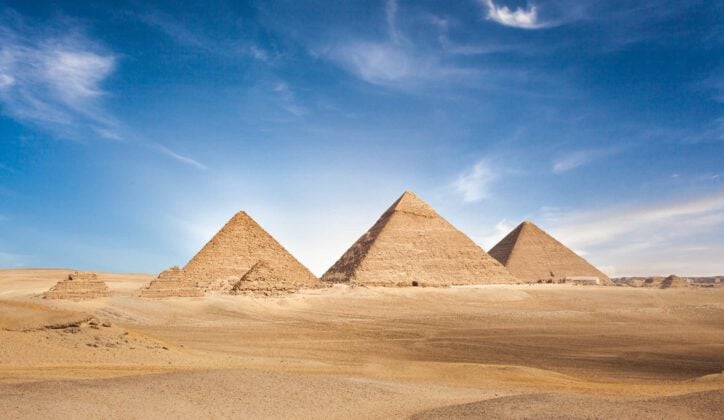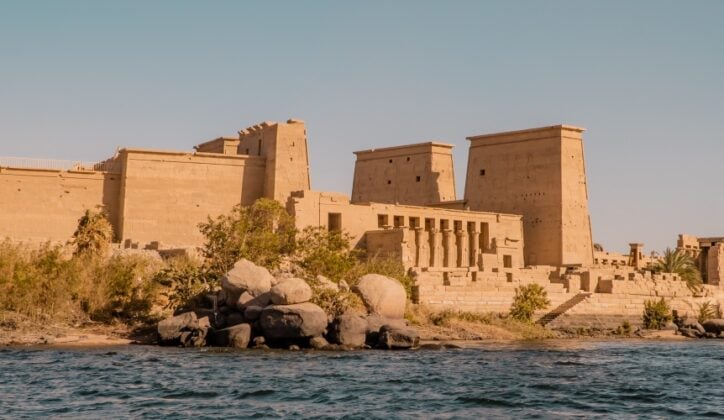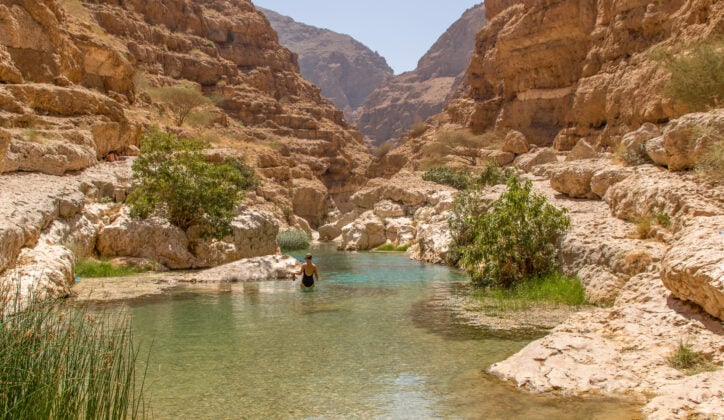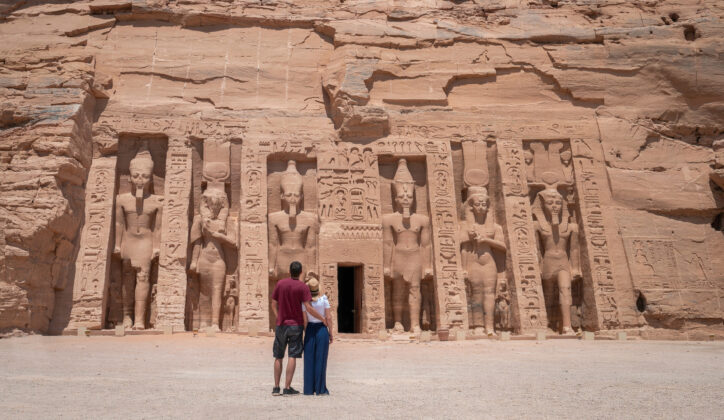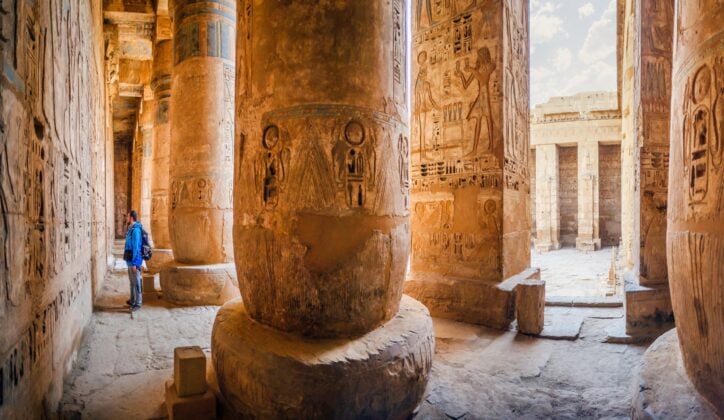Published on: December 15th, 2023
Last modified: March 21st, 2024
The best time to visit the Middle East is spring (April–May) or autumn (October–November). These months allow you to avoid the intense summer heat while still enjoying warm weather across the region. That said, it depends on your destination and interests; some months are better for certain activities in specific places.
The climate in the Middle East is varied, ranging from bone-dry deserts to lush mountain landscapes. Because the weather can be so extreme, it’s important to carefully consider the timing of your trip. Each season has its pros and cons – but ultimately the best time to travel to the Middle East will hinge on your personal preferences and plans.
What is the climate of the Middle East?
The Middle East is enormous, covering more than 7 million square kilometres, so it’s no surprise that its climate is incredibly diverse. Much of the region is desert, meaning dry conditions, sweltering days and bitterly cold nights. But it also includes tropical coastlines, bountiful valleys, rugged – and sometimes even snowy – mountains and more.
There are distinct seasonal changes in climate across the Middle East. For example, Jordan is known for having four seasons, while the UAE experiences just winter and summer with short transitional periods between them. Even within countries, you might find hot arid deserts, damp and drizzly verdant oases, chilly lofty peaks and warm sunny beaches in close proximity.
How hot is the Middle East?
Certain parts of the region can get extremely hot, including the Egyptian Sahara, southern Oman, Doha and Abu Dhabi – but it completely depends on the time of year. The hottest months in the Middle East are July and August, when temperatures can exceed 40ºC (104ºF) in some places on a daily basis.
The Middle East month-by-month climate guide
The Middle East is a relatively hot and dry region, although the weather can vary greatly between different countries, areas, times of year and even times of day. For example, Amman and Petra in Jordan can see snowfall in winter (December–February), while the Sahara and Aswan can reach 42ºC (108ºF) during summer in Egypt (July–August).
To help you understand the climate and know what to expect when travelling, we’ve put together a detailed month-by-month climate guide for the Middle East.
The Middle East in January
January is the coldest month of the year in the Middle East, bringing ideal weather to some of its otherwise sweltering destinations. It’s one of the best times of year to visit Egypt, Qatar or Oman, where temperatures average 17–25ºC (63–77ºF).
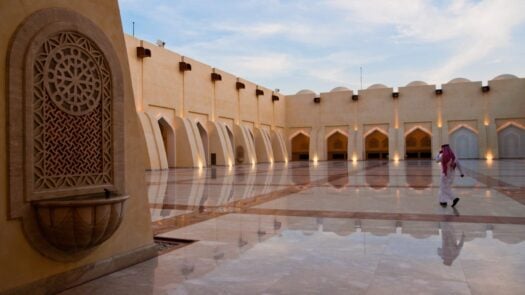
Jordan gets a bit chilly, especially in Wadi Rum and higher-altitude spots like Amman and Petra. January is also among the best times to visit Jordan if you’re hoping to see snow in the Middle East, which usually only falls at the highest elevations (over 1,000 metres).

The Middle East in February
February is among the Middle East’s colder months, although it tends to be slightly warmer than January. Despite mostly clear skies, this is when rainfall is most likely in Amman (65 millimetres on average), Dubai (35 millimetres) and parts of Oman (30 millimetres). It’s a great time to visit Petra, Muscat or Abu Simbel for the annual Sun Festival.

The Middle East in March
March marks the beginning of spring in the Middle East, with temperatures rising across the region. It’s not quite the high season yet in terms of tourism, which can create a perfect combination of smaller crowds and pleasant weather. Popular destinations in Oman and Egypt usually stay below 30ºC (86ºF) throughout the month.

Although the exact dates change every year, Ramadan often falls within March as well. This can be a fascinating time to visit the Middle East, as people come together to worship and celebrate. Just keep in mind that it has certain implications for travellers in terms of business hours and public behaviour – along with plenty of festive perks.

The Middle East in April
April is one of the best months to visit the Middle East, promising warm springtime temperatures and sunny skies. Jordan’s valleys bloom with wildflowers and Oman’s Jebel Akhdar is blanketed in roses, creating magical scenery to complement the lovely weather. Temperatures average 23ºC (73ºF) at the Dead Sea and 33ºC (91ºF) in Oman, and Egypt is especially breezy.
Ramadan often stretches into this month as well, so make sure to check in advance if you’re travelling in April.
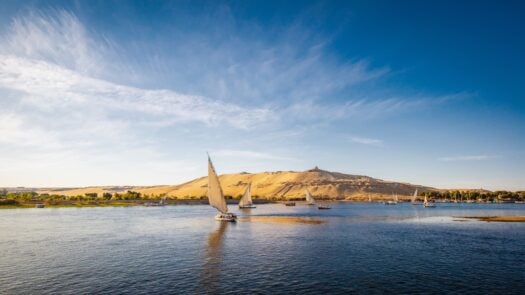
The Middle East in May
If you’re hoping for warm weather and little chance of rain, May is the best time to visit the Middle East before summer sets in. Temperatures are on the rise, but haven’t yet reached uncomfortable levels – making this an excellent time to enjoy the beaches of Aqaba or the Red Sea. Warmer water temperatures also make it a prime month for snorkelling and diving.

The Middle East in June
June marks the start of summer in the Middle East, and the accompanying heat that this region is known for. However, temperatures haven’t quite peaked yet in Jordan, Egypt, Qatar and the United Arab Emirates – so this is a good time for a slightly more comfortable summer holiday. Jordan’s highlands can still be quite cool, although Amman often reaches 30ºC (86ºF).
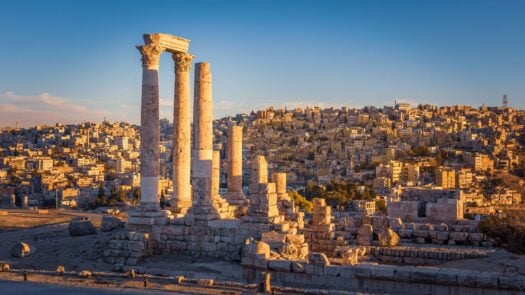
Keep in mind that June is actually the hottest month of summer in Oman, unlike some other countries. We don’t recommend sightseeing in Muscat – where temperatures can exceed 38ºC (100ºF) – but Salalah’s khareef monsoon season can provide a welcome respite from the heat.

The Middle East in July and August
July and August are the peak of summer in the Middle East, bringing the year’s highest temperatures across Jordan, Egypt, Qatar and the United Arab Emirates. Although the heat can be stifling in some places, there are still plenty of reasons to visit the region at this time of year. We suggest sightseeing early in the morning and sticking to the shade when possible.
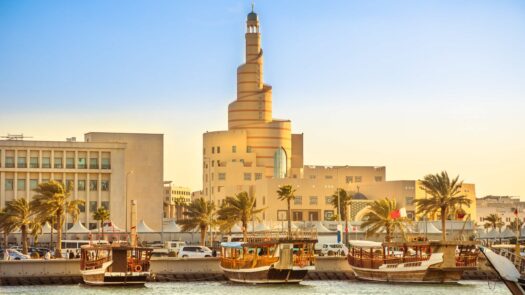
Summer also promises clear skies, meaning spectacular stargazing in Wadi Rum and other desert landscapes. It’s the best time to visit Oman if you want to see turtles hatching at Ras Al Jinz Turtle Reserve, and a lovely time to go to Alexandria in Egypt, which stays below 30ºC (86ºF).

The Middle East in September
With the summer heat already fading, September is a solid option for a trip to the Middle East. It can still be fairly hot in places like Doha, Dubai and the Dead Sea, but it’s slightly more comfortable than July and August. Similar to June, this is a good month to visit if you want to enjoy the sun and can handle some heat – usually above 30ºC (86ºF) across the region.
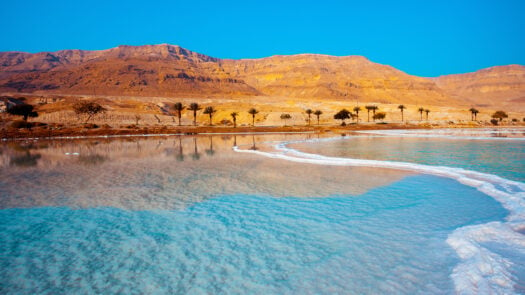
The Middle East in October
By the time October rolls around, autumn is in full swing. In the Middle East, that means balmy temperatures, clear skies and ideal conditions for sightseeing. Temperatures in Petra peak at around 27ºC (81º), but Egypt’s most popular destinations can still reach 35ºC (95ºF). In terms of weather, this is undoubtedly one of the best months to visit the Middle East.
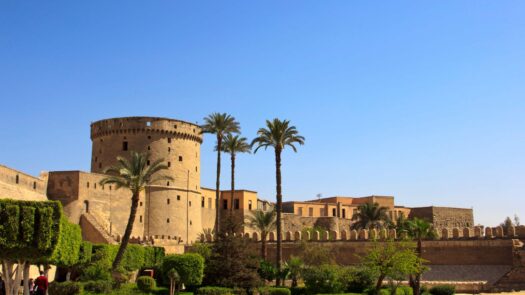
The Middle East in November
Temperatures continue to fall in November, but most of the Middle East is still pleasantly warm and sunny. In Oman, this is harvest season – keep an eye out for fresh olives, walnuts, pomegranates and more – and temperatures stay around 29ºC (84ºF). The cooler weather tends to attract more tourists to Egypt, making this a great time to explore the vast Sahara.

The Middle East in December
In the Middle East, December is similar to January in terms of weather: delightfully cool. Muscat still averages 26ºC (80ºF) but Nizwa and Al Hajar Mountains in Oman can get down to 10ºC (50ºF) at night. This is one of the best months to visit Qatar and the United Arab Emirates, and a good time to visit Jordan if you’re hoping to see snow in the Middle East.
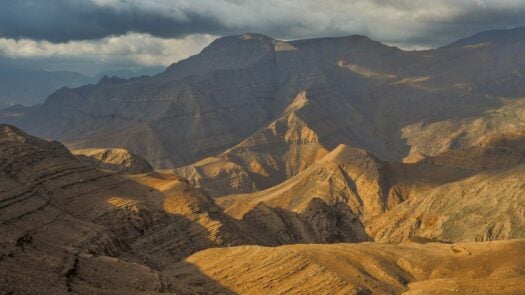
The best things to do in the Middle East by season
The best time to visit the Middle East depends in large part on what you want to do. Certain months are better for desert adventures and mountain expeditions, while others are ideal for snorkelling, sightseeing or wildlife spotting. With that in mind, here are some of the best things to do in the Middle East – and when to do them.

Discover the wonders of the undersea world
The best time to go snorkelling and diving in the Middle East depends on your destination. If you’re headed to the Red Sea, the warmer months from May to July bring the best visibility and higher water temperatures (24–26ºC/75–79ºF), as well as the chance to see hammerhead and whale sharks.
However, in Oman the best time to go snorkelling and diving is September to January, when temperatures are comparatively cooler and the water is clear. During summer (June–August), seaweed can obscure the underwater scenery.
In Aqaba you can go snorkelling or diving year round, but June and July are best for spotting whale sharks and February is ideal if you want to see manta rays.

Explore ancient archaeological sites
Visiting legendary ancient sites is definitely one of the best things to do in Egypt and an essential activity in Jordan. The best time to visit archaeological sites in the Middle East is outside of the hotter summer months (June–August). That said, if you’re travelling at this time of year you can still visit them; just try to go early in the morning (many sites open at 6am).
March–May and October–November are the best months to visit Petra and the Great Pyramids, although the pleasant weather can attract larger crowds. If you don’t mind cooler temperatures, visit Petra in February; and if you can handle the heat, the Pyramids will likely be less crowded in June.

Spot turtles and marine wildlife
The best time for wildlife spotting in the Middle East varies according to which animals you want to see. If you’ve always dreamed of watching baby sea turtles hatch from their shells, head to Ras Al Jinz Turtle Reserve in summer (July–August). You might also be able to see them in June and September, when temperatures are slightly cooler.
If you want to spot crocodiles, dolphins and waterbirds on the Nile, September is a great time to visit Egypt, promising mild breezes and warm evenings. This month also marks the start of the birdwatching season in Oman.

Spend a night in the middle of nowhere
For a true escape from the stress of modern life, there’s nothing quite like spending a night in the desert. The best time to camp out in the desert in the Middle East varies by country. In Jordan, Wadi Rum has the best conditions in April, May and October: warm days and cool nights, without extreme heat or cold.
November is one of the best months to explore the Egyptian Sahara, as many tourists flock to the cities to take advantage of cooler weather. The colder months of October to March are also perfect for adventures in Wahiba Sands – especially if you’re visiting Oman with children.

Gaze up at the glittering desert skies
The best time for stargazing in the Middle East depends on where you are. The dry summer in Jordan (July–August) offers impeccable conditions for stargazing in Wadi Rum. Because this area is at a slightly higher altitude (1,600 metres), summertime temperatures aren’t as extreme and humidity is lower than 40%, making the heat more bearable.
In Dubai, the best time of year for stargazing is winter (December–March), when skies are clearer and the climate is dry. This is also true for Qatar, which promises brilliantly starry skies for those willing to venture beyond the city lights of Doha.

Embark on an Adventurous Hike
The best time to go hiking in the Middle East is in spring or autumn, or even winter in certain places. In Oman, the cooler months of October–March promise perfect weather for hiking through the Hajar Mountains, where you’ll come across ancient ruins, charming villages and panoramic views.
If you want to wander through the wildflower-covered hills of Jordan, April is the best time of year to go hiking. This is a great month to explore the incredibly biodiverse Dana Biosphere Reserve, or to go canyoning in Wadi Mujib (which is only possible from April to October).
Trip Inpsiration
Plan your trip to the Middle East.
Whatever you want from your adventure in the Middle East, our team of expert travel designers are ready to help.
